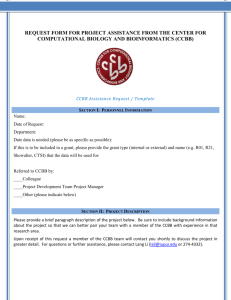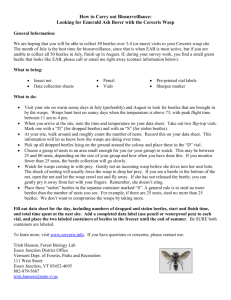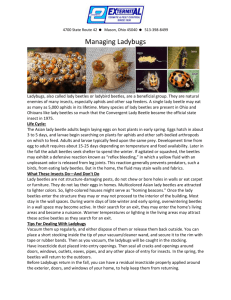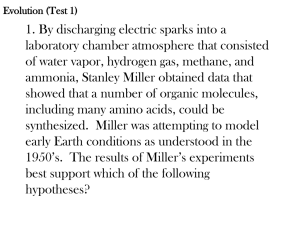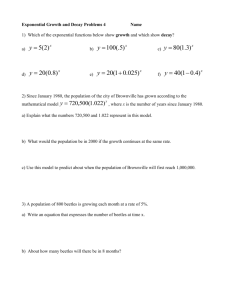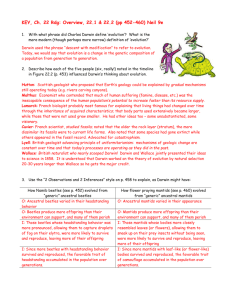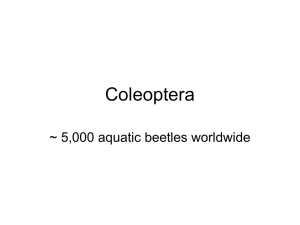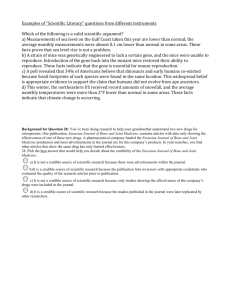Sample Multiple Choice
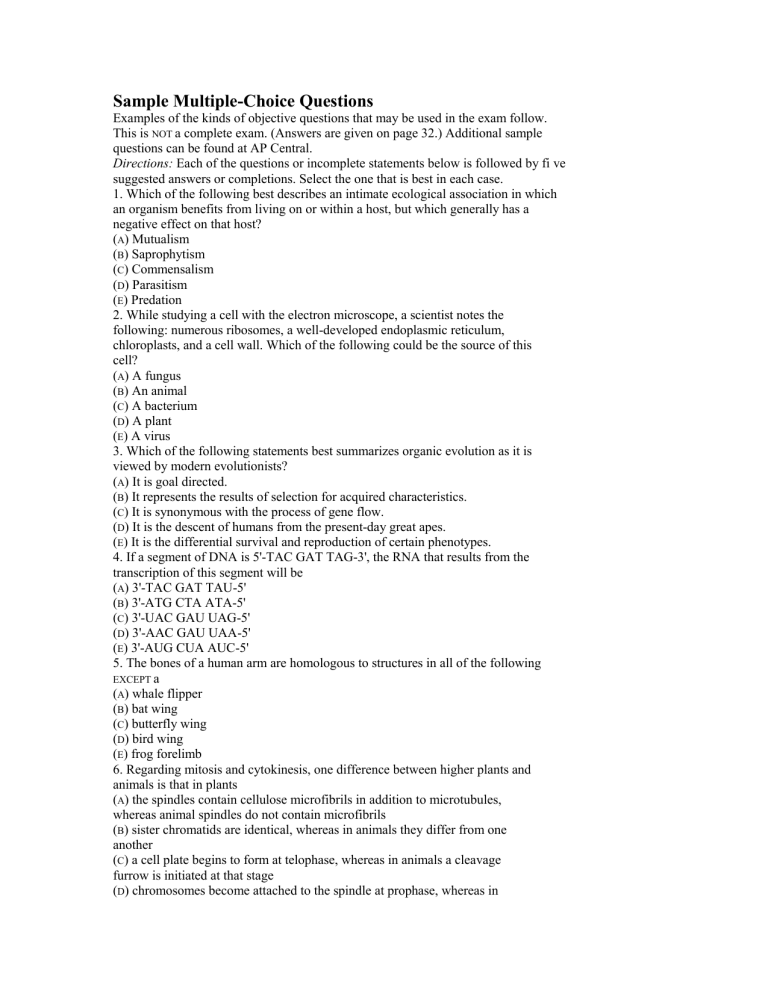
Sample Multiple-Choice Questions
Examples of the kinds of objective questions that may be used in the exam follow.
This is NOT a complete exam. (Answers are given on page 32.) Additional sample questions can be found at AP Central.
Directions: Each of the questions or incomplete statements below is followed by fi ve suggested answers or completions. Select the one that is best in each case.
1. Which of the following best describes an intimate ecological association in which an organism benefits from living on or within a host, but which generally has a negative effect on that host?
(
A
) Mutualism
( B ) Saprophytism
( C ) Commensalism
( D ) Parasitism
(
E
) Predation
2. While studying a cell with the electron microscope, a scientist notes the following: numerous ribosomes, a well-developed endoplasmic reticulum, chloroplasts, and a cell wall. Which of the following could be the source of this cell?
( A ) A fungus
( B ) An animal
( C ) A bacterium
( D ) A plant
(
E
) A virus
3. Which of the following statements best summarizes organic evolution as it is viewed by modern evolutionists?
(
A
) It is goal directed.
(
B
) It represents the results of selection for acquired characteristics.
(
C
) It is synonymous with the process of gene flow.
( D ) It is the descent of humans from the present-day great apes.
( E ) It is the differential survival and reproduction of certain phenotypes.
4. If a segment of DNA is 5'-TAC GAT TAG-3', the RNA that results from the transcription of this segment will be
(
A
) 3'-TAC GAT TAU-5'
(
B
) 3'-ATG CTA ATA-5'
(
C
) 3'-UAC GAU UAG-5'
(
D
) 3'-AAC GAU UAA-5'
( E ) 3'-AUG CUA AUC-5'
5. The bones of a human arm are homologous to structures in all of the following
EXCEPT a
(
A
) whale flipper
(
B
) bat wing
(
C
) butterfly wing
(
D
) bird wing
(
E
) frog forelimb
6. Regarding mitosis and cytokinesis, one difference between higher plants and animals is that in plants
( A ) the spindles contain cellulose microfibrils in addition to microtubules, whereas animal spindles do not contain microfibrils
( B ) sister chromatids are identical, whereas in animals they differ from one another
(
C
) a cell plate begins to form at telophase, whereas in animals a cleavage furrow is initiated at that stage
(
D
) chromosomes become attached to the spindle at prophase, whereas in
animals chromosomes do not become attached until anaphase
( E ) spindle poles contain centrioles, whereas spindle poles in animals do not
7. A common feature of starch and glycogen is that molecules of both
( A ) form microfibrils that give support to connective tissue fibers
( B ) contain repeated monomers of glucose and galactose
(
C
) are important structural components of plant cell walls
(
D
) are polymers of glucose
(
E
) are water-soluble disaccharides
8. The ancestors of land plants most likely resembled modern-day members of the
( A ) Cyanobacteria (blue-green algae)
( B ) Rhodophyta (red algae)
( C ) Chlorophyta (green algae)
( D ) Phaeophyta (brown algae)
( E ) Chrysophyta (diatoms and golden-brown algae)
9. Which of the following offers the best description of neural transmission across a mammalian synaptic gap?
(
A
) Neural impulses involve the flow of K
+ and Na
+ across the gap.
(
B
) Neural impulses travel across the gap as electrical currents.
(
C
) Neural impulses cause the release of chemicals that diffuse across the gap.
( D ) Neural impulses travel across the gap in both directions.
( E ) The calcium within the axons and dendrites of nerves adjacent to a synapse acts as the neurotransmitter.
10. Which of the following statements is true about the Krebs (citric acid) cycle and the Calvin (light-independent) cycle?
(
A
) They both result in a net production of ATP and NADH.
(
B
) They both require a net input of ATP.
(
C
) They both result in a release of oxygen.
( D ) They both take place within the cytoplasmic matrix.
( E ) They both are carried out by enzymes located within an organelle matrix.
11. Two fossil vertebrates, each representing a different class, are found in the undisturbed rock layers of a cliff. One fossil is a representative of the earliest amphibians. The other fossil, found in an older rock layer below the amphibian, is most likely to be
(
A
) a dinosaur
(
B
) a fish
(
C
) an insectivorous mammal
(
D
) a snake
( E ) a bird
12. The bonding of two amino acid molecules to form a larger molecule requires
( A ) the release of a water molecule
(
B
) the release of a carbon dioxide molecule
(
C
) the addition of a nitrogen atom
(
D
) the addition of a water molecule
(
E
) an increase in activation energy
13. If young male zebra finches are raised by foster parents of another species, the
Bengalese finch, they will court female Bengalese finches instead of females of their own species. This behavior results from which of the following?
( A ) Imprinting
(
B
) Habituation
(
C
) Conditioning
(
D
) Reinforcement
(
E
) Pheromones
14. The relative location of four genes on a chromosome can be mapped from the
following data on crossover frequencies
Genes Frequency of Crossover
B and D 5%
C and A 15%
A and B 30%
C and B 45%
C and D 50%
Which of the following represents the relative positions of these four genes on the chromosome?
( A ) ABCD
( B ) ADCB
( C ) CABD
( D ) CBAD
( E ) DBCA
15. When hydrogen ions are pumped out of the mitochondrial matrix, across the inner mitochondrial membrane, and into the space between the inner and outer membranes, the result is
(
A
) damage to the mitochondrion
(
B
) the reduction of NAD
( C ) the restoration of the Na-K balance across the membrane
( D ) the creation of a proton gradient
( E ) the lowering of pH in the mitochondrial matrix
16. Once transcribed, eukaryotic mRNA typically undergoes substantial alteration that results primarily from
(
A
) excision of introns
(
B
) fusion into circular forms known as plasmids
(
C
) linkage to histone molecules
( D ) union with ribosomes
( E ) fusion with other newly transcribed mRNA molecules to form larger translatable units
17. The function of water in photosynthesis is to
(
A
) combine with CO
2
(
B
) absorb light energy
(
C
) supply electrons in the light-dependent reactions
(
D
) transport H
+ ions in the light-independent (dark) reactions
(
E
) provide O
2 for the light-independent (dark) reactions
Questions 18–19
Questions 18–19 refer to the diagram below of the adult human heart.
18. Chambers or vessels that carry oxygenated blood include which of the following?
( A ) 3 only
( B ) 1 and 2 only
(
C
) 5 and 6 only
(
D
) 1, 2, and 3
(
E
) 3, 5, and 6
19. The correct sequence of blood flow beginning at the pulmonary arteries and passing through the lungs and the systemic circulation is
( A ) 2 - 1 - 4 - systemic - 3 - 6 - 5 - 7 - lungs
( B ) 3 - 6 - 5 - 7 - systemic - 4 - 1 - 2 - lungs
(
C
) 4 - lungs - 7 - 5 - 6 - 3 - systemic - 2 - 1
( D ) 6 - 4 - lungs - 3 - systemic - 2 - 1 - 5 - 7
( E ) 7 - 5 - 6 - systemic - 2 - 1 - 4 - lungs – 3
Directions: Each set of lettered choices below refers to the numbered words or statements immediately following it. Select the one lettered choice that best fi ts each word or statement. A choice may be used once, more than once, or not at all in each set.
Questions 20–23
The figure below represents a food web in a particular ecosystem. Each letter represents a species. The arrows indicate the direction of energy flow.
20. Which species would most likely represent humans if they were part of this ecosystem?
21. A photosynthetic organism would be represented by which species?
22. Members of which species are herbivores?
23. Members of which species are most likely to be omnivorous?
Questions 24–27
(
A
) Centriole
(
B
) Lysosome
(
C
) Nucleolus
(
D
) Peroxisome
( E ) Ribosome
24. Found in both prokaryotic and eukaryotic cells
25. Possesses a microtubular structure similar in form to a basal body
26. Assembles ribosomal precursors
27. Contains hydrolytic enzymes associated with the intracellular digestion of macromolecules
Questions 28–30
( A ) Grassland
(
B
) Taiga
(
C
) Deciduous forest
(
D
) Tundra
(
E
) Tropical rain forest
28. This biome exhibits the greatest diversity in plant species.
29. In this biome, agriculture is commonly practiced in a “cut- burn-cultivateabandon’’ mode.
30. This biome can be recognized by its coniferous forests and relatively infertile, acidic soil.
Directions: Each group of questions below concerns an experimental or a laboratory situation. In each case, first study the description of the situation. Then choose the one best answer to each question following it.
Questions 31–32
Questions 31–32 refer to the data presented in the graph below of tobacco cells grown in tissue culture. The numbers on the curves indicate the concentrations of indoleacetic acid (IAA) in milligrams per liter.
31. The optimum concentrations of hormones for promoting maximum tobacco cell growth are
(
A
) 27 mg/liter of IAA alone
(
B
) 27 mg/liter of IAA and 2.56 mg/liter of kinetin
( C ) 27 mg/liter of IAA and 0.64 mg/liter of kinetin
(
D
) 2 4 mg/liter of IAA and 0.64 mg/liter of kinetin
(
E
) 2 1 mg/liter of IAA and 0.64 mg/liter of kinetin
32. The purpose of the experiment is primarily to determine the
( A ) effect of IAA on the growth of tobacco cells
( B ) amount of hormone normally released by tobacco cells in tissue culture
( C ) response of tobacco cells in tissue culture to synthetic hormones
(
D
) response of kinetin to various concentrations of IAA only
(
E
) response of tobacco cells in tissue culture to combinations of IAA and kinetin
Questions 33–34
A sterile agar plate, I, is streaked with a pure culture of bacteria by means of aseptic techniques. Paper discs treated with the antibiotics Aureomycin ( A ) and penicillin ( P ) are placed at opposite sides of the plate, as shown in the diagram above. The plate is examined after a 24-hour incubation period, and a clear ring is discovered around disc
A , but not around disc P . Within the clear ring around disc A , a single bacterial colony with physical characteristics like those of the pure culture is observed. A second sterile agar plate, II, is then streaked with this single colony and also incubated with antibiotics.
33. The single colony found within the clear ring in plate I is most likely made up of the descendants of a bacterial cell that
( A ) contaminated the agar plate
( B ) contained information conferring resistance to Aureomycin
( C ) changed its response to Aureomycin as a result of being exposed to the antibiotic
( D ) was susceptible to both penicillin and Aureomycin
(
E
) emigrated from another area of the agar plate
34. Which of the following would most likely be observed in plate II after 24 hours?
(
A
) A clear ring larger than that around disc A in plate I would appear around disc A only.
(
B
) A clear ring larger than that around disc A in plate I would appear around disc P only.
( C ) A clear ring smaller than that around disc A in plate I would appear around disc P only.
(
D
) There would be a clear ring around both disc A and disc P .
(
E
) There would not be a clear ring around either disc A or disc P .
Questions 35–37
In dogs, one pair of alleles determines coat color (dark and albino). Another pair of alleles determines hair length (short and long). Thus, each gamete will contain one of the coat-color alleles, C or c, and one of the hair-length alleles, B or b . In repeated crosses of a specifi c dark, short-haired dog with an albino, long-haired dog, all the offspring were dark with short hair, as shown in cross I. However, in subsequent crosses of another dark, short-haired dog with a dark, long-haired dog, the ratios shown in cross II below were obtained.
Cross Parents Offspring
I. Dark, short hair x Albino, long hair All dark, short hair
II. Dark, short hair x Dark, long hair 3 dark, short hair
3 dark, long hair
1 albino, short hair
1 albino, long hair
35. In cross II, the genotype of the dark, short-haired parent is
( A ) CcBb
(
B
) ccbb
( C ) CCBB
( D ) CCbb
( E ) ccBB
36. Which of the following is probably the genotype of the dark, short-haired parent in cross I?
(
A
) CcBb
(
B
) ccbb
(
C
) CCBB
( D ) CCbb
( E ) ccBB
37. Which of the following correctly describes the relationship of the dark-coat-color allele to the albino condition?
( A ) It is dominant.
(
B
) It is recessive.
(
C
) It is codominant.
(
D
) It is a polygenic inheritance pattern.
(
E
) The alleles are linked.
Questions 38–40
A large population of laboratory animals has been allowed to breed randomly for a number of generations. After several generations, 49 percent of the animals display a recessive trait ( bb ), the same percentage as at the beginning of the breeding program.
The rest of the animals show the dominant phenotype, with heterozygotes indistinguishable from the homozygous dominants.
38. What is the most reasonable conclusion that can be drawn from the fact that the frequency of allele b has not changed over time?
( A ) The population is undergoing genetic drift.
(
B
) The two phenotypes are equally adaptive under laboratory conditions.
(
C
) The genotype BB is lethal.
(
D
) There has been a high rate of mutation of allele B to allele b .
(
E
) There has been sexual selection favoring allele b .
39. What is the frequency of allele b in the gene pool?
( A ) 0.70
( B ) 0.51
( C ) 0.49
(
D
) 0.30
(
E
) 0.07
40. What proportion of the population is heterozygous ( Bb ) for this trait?
(
A
) 0.51
(
B
) 0.42
( C ) 0.21
( D ) 0.09
( E ) 0.07
Questions 41–42
Questions 41–42 refer to an experiment that is set up to determine the relative volume of O
2 consumed by germinating and nongerminating (dry) pea seeds at two different temperatures. The change in volume is detected by using a respirometer over a given period of time. The data are given below.
41. The rate of oxygen consumption in germinating pea seeds at 26ºC is
(
A
) 0.05 mL / min
(
B
) 0.25 mL / min
(
C
) 0.50 mL / min
(
D
) 0.75 mL / min
(
E
) 1.00 mL / min
42. Which of the following conclusions is best supported by the data?
(
A
) Nongerminating pea seeds have a higher rate of respiration than germinating pea seeds do.
( B ) Light is required for pea seed germination.
( C ) In the nongerminating pea seeds, oxygen consumption is directly proportional to oxygen concentration.
(
D
) Less carbon dioxide is produced by germinating pea seeds at 26ºC than at
10ºC.
(
E
) In pea seeds an increase in temperature results in an increase in oxygen consumption.
Questions 43–45
Individuals of a particular species of ground beetle are either light tan or dark brown.
Light-tan beetles are predominant in habitats with light-colored sandy soils, and darkbrown beetles are predominant in habitats with dark-colored loam soils. In an experiment designed to determine the survival rates of light-tan beetles and darkbrown beetles in different habitats, 500 light-tan beetles and 500 dark-brown beetles were released in each of four habitats. Each beetle had been marked with a small spot of red paint on the underside of its abdomen before it was released. One week after the beetles had been released, any marked beetles that could be found were recaptured.
The results are presented in the table below. It is assumed that differences in the numbers of beetles recaptured are directly related to differences in survival rates.
43. Which of the following processes best explains why fewer light-tan beetles than dark-brown beetles were recaptured in habitat 4?
( A ) Immigration
( B ) Genetic drift
( C ) Mutation
( D ) Adaptive radiation
(
E
) Predation
44. If all insectivorous birds and remaining beetles were removed from habitat 2 and
500 additional dark-brown beetles and 500 additional light-tan beetles were then released into habitat 2, which of the following is the best estimate of the number of additional dark-brown beetles that would be expected to be recaptured in habitat 2 after one more week?
( A ) 0
( B ) 22
( C ) 120
(
D
) 220
(
E
) 500
45. Which of the following can be inferred from the data in the table?
(
A
) Ground beetles do not emigrate from the habitat in which they live.
(
B
) Insectivorous birds prefer to eat light-tan beetles rather than dark-brown beetles.
( C ) Ground beetles have higher rates of survival in habitats with loam soil.
( D ) Insectivorous birds are predators of this species of ground beetle.
( E ) The reproductive success of beetles in habitats with sandy soils is greater than that of beetles in habitats with loam soils.
